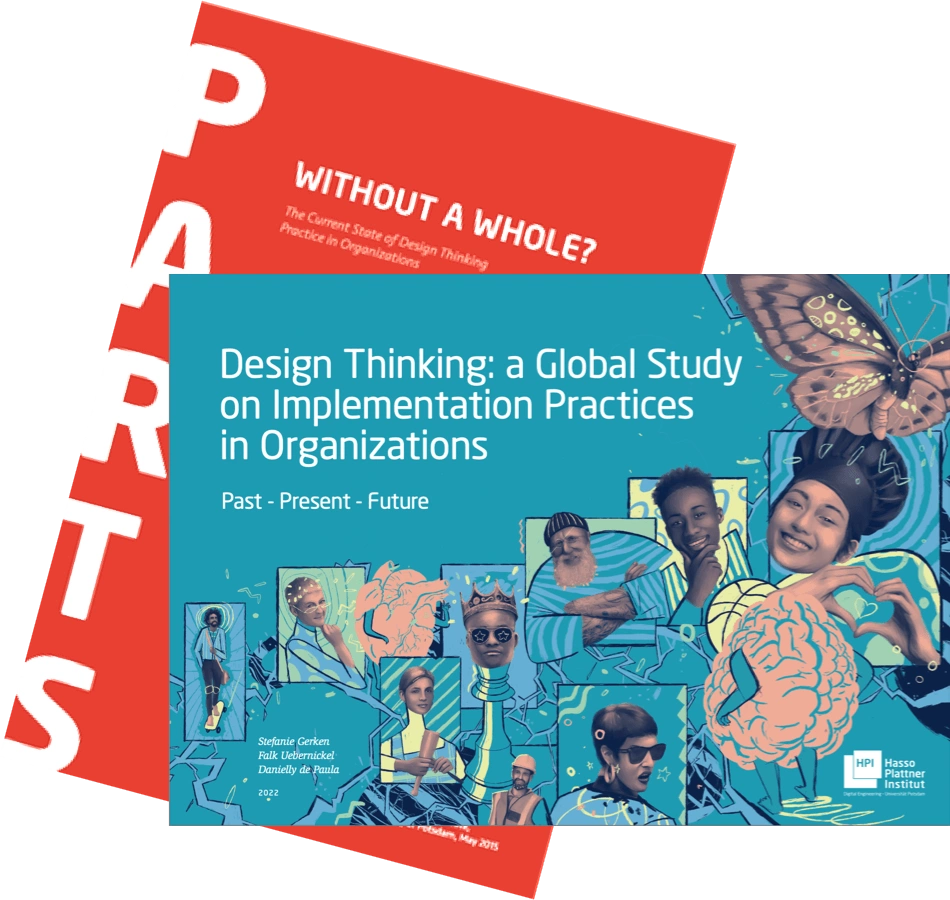In October 2015 the report “Parts Without a Whole? – The Current State of Design Thinking Practice in Organizations”, was published. The exploratory study looked at the many forms of design thinking adoption in organizations. You can download the old study here.
Now, five years later, we are happy to announce that a team of design thinking researchers at the HPI Potsdam has published the follow-up study called: “Design Thinking – A Global Study on Implementation Practices in Organizations.” You can download the new study here.
Study Report “Design Thinking – A Global Study on Implementation Practices in Organizations.” (2022)
These days design thinking is no longer a “new approach”. Among practitioners, as well as academics, interest in the topic has gathered pace over the last two decades. However, opinions are divided over the longevity of the phenomenon: whether design thinking is merely “old wine in new bottles,” a passing trend, or still evolving as it is being spread to an increasing number of organizations and industries. Despite its growing relevance and the diffusion of design thinking, knowledge on the actual status quo in organizations remains scarce. With a new study, the research team of Prof. Uebernickel and Stefanie Gerken investigates temporal developments and changes in design thinking practices in organizations over the past six years comparing the results of the 2015 “Parts without a whole” study with current practices and future developments. Companies of all sizes and from different parts of the world participated in the survey. The findings from qualitative interviews with experts, i.e., people who have years of knowledge with design thinking, were cross-checked with the results from an exploratory analysis of the survey data. This analysis uncovers significant variances and similarities in how design thinking is interpreted and applied in businesses.
Keywords
design thinking, innovation, innovation management, innovation capabilities, organizational change, change management, management, adoption, diffusion, study, leadership
Study Report “Parts Without A Whole” (2015)
The explorative study gives a descriptive overview of what organizations do and experience when they say they practice design thinking. It looks at how the concept has been appropriated in organizations and also describes patterns of design thinking adoption. The authors use a mixed-method research design fed by two sources: questionnaire data and semi-structured personal expert interviews. The study proceeds in six parts: (1) design thinking’s entry points into organizations; (2) understandings of the descriptor; (3) its fields of application and organizational localization; (4) its perceived impact; (5) reasons for its discontinuation or failure; and (6) attempts to measure its success. In conclusion, the report challenges managers to be more conscious of their current design thinking practice. The authors suggest a co-evolution of the concept’s introduction with innovation capability building and the respective changes in leadership approaches. It is argued that this might help in unfolding design thinking’s hidden potentials as well as preventing unintended side-effects such as discontented teams or the dwindling authority of managers.
Keywords
design thinking, innovation, innovation management, innovation capabilities, organizational change, change management, management, adoption, diffusion, study, leadership

